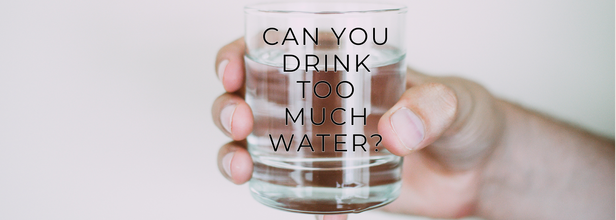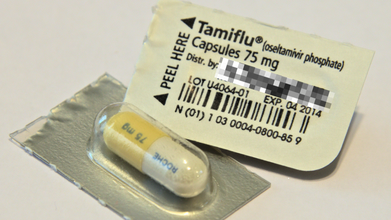- Health Conditions A-Z
- Health & Wellness
- Nutrition
- Fitness
- Health News
- Ayurveda
- Videos
- Medicine A-Z
- Parenting
Can You Drink Too Much Water?

Image Credit: Canva
From controlling body temperature and flushing out toxins, adequate hydration plays a vital role in our general health and well-being, water is a life essential. However, while dehydration garners significant attention, overhydration, or drinking excessive amounts of water, is a condition that can have serious and sometimes fatal consequences.
Although it may sound bizarre since drinking water is said to be the solution for most health related problems it is important to recognize how much water is considered "too much" or the risks involved with being overhydrated can maintain a healthy balance.
What Is Water Intoxication?
Water intoxication, also termed hyperhydration, water poisoning or water toxemia, develops when an individual drinks much more water than the kidney can excrete. The main function of the kidneys in the human body is the processing and excretion of excess water. However, the human kidneys can process only up to 0.8 to 1.0 liters of water at a time. Drinking an amount that exceeds this may overwhelm the kidneys and put the electrolyte balance out of sync in the human body.
Electrolytes, especially sodium, are essential in maintaining fluid balance within and outside cells. Hyponatremia is the condition when sodium levels fall below 135 mmol/L, resulting from excessive water intake. This causes water to shift into cells, swelling them. In the brain, this can cause severe complications, including coma or even death.
Symptoms of Water Intoxication
The symptoms of water intoxication vary from mild to severe. Early symptoms are often similar to dehydration, which makes self-diagnosis challenging. Common symptoms include:
- Headaches
- Nausea and vomiting
- Muscle cramps or weakness
- Fatigue or drowsiness
- Confusion and disorientation
In more serious cases, water intoxication can cause seizures, loss of consciousness, or swelling in the brain. These complications can be fatal if left untreated.
A notable case occurred in 2007 when a woman participating in a water-drinking contest tragically died after consuming nearly two gallons of water in under two hours. More recently, actress Brooke Shields experienced a grand mal seizure attributed to excessive water consumption.
Causes of Water Intoxication
Water intoxication is rare, but certain scenarios can increase the risk:
1. Sporting Events and Endurance Training
These endurance athletes are prone to water intoxication, especially if they drink large amounts of water without replacing lost electrolytes. Hyponatremia usually happens during long races or marathons as individuals mistake fatigue and muscle cramps for dehydration and continue drinking water in excess.
2. Military Training
Overhydration among military personnel is usually due to severe physical activity in extreme environmental conditions. The total number of hyponatremia cases documented from 2007 through 2022 for the active duty in the United States exceeds 1,600, with a note to this problem on exertion-related overhydration.
3. Mental Health Conditions
Compulsive water drinking, known as psychogenic polydipsia, is linked with some mental illnesses such as schizophrenia and psychosis. People with these conditions tend to drink too much water, causing a hazardous electrolyte imbalance.
4. Drug Abuse
Drugs such as MDMA (ecstasy) raise the body temperature and make people thirsty, and at times, some people tend to drink excess water at events like music festivals. MDMA also leads to urine retention, thus exacerbating the dangers of water intoxication.
How Much Water Is Too Much?
The exact amount of water that causes intoxication varies from one person to another. However, drinking more than 1 liter of water per hour for several hours raises the risk. For healthy individuals, the risk of overhydration is low unless taking part in extreme physical activity or ignoring thirst cues.
Certain medical conditions, such as kidney or liver disorders, can impair the body's ability to process fluids, and even moderate water intake may be harmful. Similarly, certain medications, such as diuretics and antipsychotics, can affect the perception of thirst or fluid regulation.
How Much Water Is Enough?
The widely touted recommendation of eight 8-ounce glasses of water per day has little basis in fact. According to the National Academy of Medicine, a daily total fluid intake is about 15 cups (3.7 liters) for males and 11 cups (2.7 liters) for females, from beverage sources and from food. Usually, about 20 percent of daily hydration comes from foods such as fruits and vegetables.
A better rule of thumb is to listen to your body and drink water based on thirst. Use the color of your urine as an indicator:
- Light yellow urine indicates proper hydration.
- Dark yellow urine may indicate dehydration.
Older adults, whose thirst mechanisms may decline with age, should be proactive about maintaining hydration, especially during illness or hot weather.
Water Intoxication vs. Dehydration
The symptoms of water intoxication—such as headaches, fatigue, and muscle weakness—are similar to those of dehydration. If you are unsure which condition you are experiencing, seek medical attention immediately rather than self-treating with more water.
Preventing Water Intoxication
To avoid the dangers of overhydration:
- Drink water gradually throughout the day rather than consuming large amounts at once.
- Replace lost electrolytes post high-intensity exercise or heavy sweating.
- Consider using sports drinks or salty snacks to help replenish sodium.
- Keep track of fluid consumption during long-duration activities, and do not consume more water than the body is losing in terms of electrolytes.
- If on medications or have specific medical conditions, check with your doctor regarding the safety of drinking water.
For signs of severe water intoxication-including confusion, drowsiness, seizures, and loss of consciousness-customer is advised to seek medical assistance immediately. In the meanwhile, a salty snack would help to temporarily correct low sodium levels.
Hydration is important to health, but overhydration can be a serious risk; the secret is in finding a balance. Drink enough water to satisfy your body, but not so much that it overwhelms your system. Remember, water is life, but moderation keeps it that way.
Hyponatremia (low sodium level in the blood). National Kidney Foundation. 2023.
Water Toxicity. NIH. 2023
Exercise-Associated Hyponatremia: 2017 Update. Front Med (Lausanne). 2017
Update: Exertional Hyponatremia Among Active Component Members of the U.S. Armed Forces, 2007–2022
36% Of Rabies Death Comes From India: This Is What You Should Do After A Dog Bite, Explains Doctor

Credits: iStock
The World Health Organization (WHO), notes that 36% of world's rabies deaths come from India, and a 2024 Lancet study notes that the country accounts for over one-third of global rabies deaths. When we spoke to Dr Aniket Mule, Consultant Internal Medicine at KIMS Hospital, Thane, he said that it is not just dog bites that lead to rabies, but it could happen from any rabies-susceptible animal. The first line of defense after you clear your wound immediately is to get the rabies vaccine. "Rabies vaccination is required for bites or scratches from any rabies-susceptible animal, including cats, monkeys, bats, foxes, and other wild mammals," he pointed out. As the country's apex court ruled and issued directives on stray dogs, focusing on public safety by ordering their removal, global health organizations, including WHO point out that this is not the right way to deal with rabies issue. Comprehensive methods including evidence=based strategies that center on mass dog vaccination is the key to the problem.
However, before this could be implemented, here's what you should know about dog bites and rabies.
What To Do After A Dog Bites Or Scratches You?
Dr Mule points out that even when there are minor scratches, without bleeding, you must get a rabies shot. "Rabies can be contracted through broken skin. Such exposures still require medical evaluation and, in most cases, rabies vaccination."
Read: In An 'Exceptionally Rare' Case, Man Dies Of Rabies After Kidney Transplant
What Should One Do Immediately After Being Bitten Or Scratched?
- Wash the wound immediately for at least 15 minutes with soap and running water
- Apply an antiseptic such as povidone-iodine
- Do not apply home remedies like turmeric, chili or oil
- Seek medical care promptly for rabies vaccination and possible immunoglobin
Dr Mule points out that the rabies vaccine should be started as soon as possible. "Ideally within 24 hours of a bite or scratch. However, even if there is a delay of days or weeks, vaccination should still be started immediately as rabies has a variable incubation period," he says.
After the bite, the immediate medical attention involves rabies post-exposure prophylaxis or PEP, and with a tetanus booster. Some rabies vaccines also use saline water as the diluent to reconstitute the freeze-dried powder before injection.
Read: Australia Issues Advisory Warning Travelers Of Counterfeit Rabies Vaccines Found In India
The temperature of the vaccine matters. "Rabies vaccines are temperature-sensitive and must be stored between 2°C and 8°C. Exposure to heat or freezing can reduce vaccine potency. Poor cold-chain maintenance is a known reason for vaccine failure in rare cases," points out the doctor.
Cases Of Rabies Coming Back After Vaccination Course Has Been Done
Dr Mule points out that in order to avoid such things happening, one must ensure immediate wound washing, timely vaccination, and correct use of Rabies Immunoglobulin or RIG. Rabies can come back if these following things occur:
- Delay in starting vaccination
- Failure to administer Rabies Immunoglobulin (RIG) in severe (Category III) exposures
- Improper wound cleaning
- Incorrect injection site (gluteal region)
- Poor vaccine storage (cold-chain failure)
Dr Mule points out that the vaccine should be given intramuscularly in the deltoid or upper arms for adults, as gluteal or buttock injections could lead to inadequate absorption and reduce effectiveness.
How Many Doses Should One Get?
- For someone not previously vaccinated, the current standard is 4 doses on days 0, 3, 7, and 14 (intramuscular schedule).
- In some government programs or intradermal schedules, 3–4 doses may be advised.
- Previously vaccinated individuals require only 2 booster doses (days 0 and 3).
The exact schedule depends on vaccination history and the protocol followed.
Five Essential Health Tests to Consider This Winter, According To A Doctor

Credits: iStock
Winter in India is often associated with sardio ke laddoo, but also with increasingly sedentary lifestyle, worsening air pollution, all of which leads to more time spending home than to going out, taking a stroll, working out and more. This is why as winter sets in, India also sees a quiet but consistent rise in non communicable diseases, or NCDs, conditions that now account for nearly two thirds of all deaths in the country. Heart disease, diabetes, thyroid disorders, fatty liver disease and arthritis continue to rise across age groups, driven by sedentary lifestyles, dietary excess and delayed diagnosis.
Winter can further aggravate these risks. Physical activity drops, calorie dense foods become routine, sunlight exposure reduces and metabolism changes. Studies and hospital data in India have repeatedly shown that heart attacks and strokes tend to spike during colder months. Blood vessels constrict, blood viscosity increases and cholesterol levels often rise. Blood sugar control also becomes more challenging, while joint pain and stiffness worsen for many.
Dr. Mayanka Lodha Seth, Chief Pathologist at Redcliffe Labs, says the problem is not seasonal food but seasonal neglect. “Traditional winter foods are not harmful on their own. The real risk comes from consuming them without understanding what is happening inside the body,” she explains. “Winter tends to mask symptoms while quietly worsening internal imbalances.”
With India already home to over 100 million people living with diabetes and a similar number estimated to be prediabetic, preventive testing becomes crucial. Doctors recommend five key tests that can offer a clearer picture of health before winter indulgence begins.
Blood Sugar Levels
Diabetes is one of the fastest growing NCDs in India, and a large proportion of cases remain undiagnosed. Winter diets high in sugar and fat can trigger frequent glucose spikes. Testing fasting blood sugar and HbA1c helps identify early risk and prevents long term complications affecting nerves, kidneys and the heart.
Lipid Profile
High cholesterol is a major contributor to cardiovascular disease, which remains India’s leading cause of death. Reduced activity in winter often pushes lipid levels higher. A lipid profile helps assess heart risk and guides dietary and lifestyle moderation before damage sets in.
Liver Function Test
Non alcoholic fatty liver disease is increasingly common in India, even among younger adults. Excess sugar and fat intake during winter can worsen liver fat accumulation. Early liver testing can flag reversible changes before they progress to chronic liver disease.
Thyroid Function Test
Thyroid disorders affect millions in India, especially women, and often go unnoticed. Symptoms like weight gain, fatigue and cold intolerance are frequently brushed off as winter sluggishness. A simple thyroid test helps distinguish seasonal lethargy from hormonal imbalance.
Vitamin D and Vitamin B12 Levels
Vitamin D deficiency is widespread due to limited sun exposure in winter, while Vitamin B12 deficiency remains common because of dietary patterns. Both deficiencies are linked to low immunity, muscle pain, bone weakness and worsening joint discomfort.
Dr. Seth adds, “Preventive diagnostic testing allows people to make informed choices. It helps them enjoy winter foods in moderation without unknowingly worsening an underlying condition.”
As NCD related healthcare costs continue to rise in India, early testing offers both health and financial protection. Winter comfort does not have to come at the cost of long term health. Staying informed may be the most effective preventive step this season.
Tamiflu Isn't The Only Flu Medicine, Expert Shares Other Alternative

Credits: iStock
Flu season is hitting hard this year, and the symptoms could feel relentless. People are suffering from rising fever, hacking cough, blocked and stuffy nose and sore throat. While many people get relief from Tamiflu, which is a prescribed antiviral medication that is used to treat or even to prevent illness, there are other alternatives available too.
Dr Ari Brown, a Texas based pediatrician and the author of Baby411 book series told CNN health that one of the most common complaints that she gets to hear from Tamiflu is vomiting. A 2023 study published in the Pediatric Infectious Disease Journal notes that 18% of people experienced vomiting with Tamiflu, as compared to 5% with Xofluza, an alternative.
“I’ve also had a few pediatric patients experience moodiness with Tamiflu, which is reported in the literature,” she said.
Read: Adenovirus Cases Rise In UK, Health Authorities On Alert
Tamiflu is usually gives to treat flu in people ages 2 weeks and older and to reduce the chance of getting the flu in people 1 year and older. The medicine could be administered in both form, liquid and capsules and usually taken twice daily for five days straight. This is prescribed for when flu is to be treated. However, when used for prevention, it is typically taken once for 10 days.
What Are The Other Alternatives Available For Flu Treatment?
Xofluza: It is administered as a single dose tablet and is approved for ages 5 and older. This medicine can also be used to treat or to prevent the flu. While it costs nearly $200 for those without insurance, eligible patients can use coupons to lessen costs. Dr Brown points out that this medicine could have side effects like diarrhea and vomiting. However, the study aforementioned notes that for this, only 5% patients had vomiting symptoms, when compared with Tamiflu.
Dr Brown also said that Xofluza can stop viral shedding in one day, while Tamiflu could take up to three days. "Both antivirals will help reduce the duration of misery by couple of days," she pointed out.
Dr Brown also pointed out that overall, "Xofluza is rising in popularity over Tamiflu." “One dose. Fewer side effects. More insurances are covering the cost of it now and manufacturer coupon makes it less expensive than in previous years," she said.
Rapivab: This is another prescribed medication that is approved to treat flu. This could be administered for people ages 6 months and older. It has to be given by a health care provider, as it is given once as an intravenous infusion. It could cost up to $1,000 without insurance and most common reaction in adults is diarrhea.
Relenza: This flu medication is inhaled in powder form. It is administered through an inhaler device, which is to be used twice a day for five days straight. The prescribed drug is approved to treat flu in ages 7 and older and for preventative use, in ages 5 and older. It could cost about $90 without insurance.
It may have side effects like dizziness, allergic reaction, or irritation of the nose. It is not recommended for people who have breathing issues or have asthma.
© 2024 Bennett, Coleman & Company Limited

